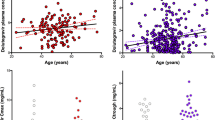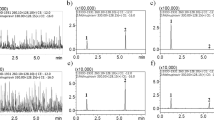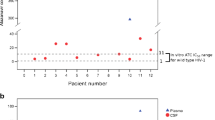Abstract
To determine if there is active efflux of zidovudine (ZDV) and 2′,3′-dideoxyinosine (ddl) out of the cerebrospinal fluid (CSF), and if this efflux is saturable, we investigated the steady-state CSF/plasma concentration ratio of the two drugs when administered alone or in combination. Constant-rate infusions of ZDV, ddl or both were administered to seven macaques (Macaca nemestrina) through a chronic venous catheter for a minimum of 28 hr. Antipyrine, a marker of passive diffusion, was coinfused in all experiments. Blood (5 mL) and CSF samples (0.5–1 mL) were collected by venous and lumbar/thoracic punctures, respectively, at 24 and 28 hr after beginning the infusion. When ZDV and ddl were administered alone, the steady-state CSF/plasma concentration ratios were significantly different from unity (ZDV, 0.20 ± 0.08; ddI, 0.09 ± 0.04) and were independent of the plasma concentration (P > 0.05). In contrast, the CSF/plasma concentration ratio of antipyrine (0.82 ± 0.19) was close but significantly smaller than unity (P > 0.05). The CSF/ plasma concentration ratios after simultaneous administration of ZDV and ddI were not significantly different (P > 0.05) from those obtained after administration of the drugs alone. These results suggest that ZDV and ddI are actively transported out of the CSF; however, within the concentration range studied, this efflux is neither saturable nor mutually competitive. Concomitant administration of ZDV and ddI did not produce a systemic interaction in the animals, indicating that the pharmacokinetics of either drug is unaffected by the presence of the other.
Similar content being viewed by others
REFERENCES
C. K. Petito. Review of central nervous system pathology in human immunodeficiency virus infection. Ann. Neurol. 23(Suppl.):S54–S57 (1988).
P. Portegies, J. de Gans, J. M. A. Lange, M. M. A. Derix, H. Spelman, M. Bakker, S. A. Danner, and J. Goldsmit. Declining incidence of AIDS dementia complex after introduction of zidovudine treatment. Br. Med. J. 299:819–821 (1989).
N. R. Hartman, R. Yarchoan, J. M. Pluda, R. V. Thomas, K. S. Marczyk, S. Broder, and D. G. Johns. Pharmacokinetics of 2′,3′-dideoxyadenosine and 2′,3′-dideoxyinosine in patients with severe human immunodeficiency virus infection. Clin. Pharmacol. Ther. 47:647–654 (1990).
B. A. Larder, G. Darby, and D. D. Richman. HIV with reduced sensitivity to zidovudine (AZT) isolated during therapy. Science 243:1731–1734 (1989).
D. D. Richman, M. A. Fischl, M. H. Grieco, M. S. Gottlieb, P. A. Volberding, O. L. Laskin, J. M. Leedom, J. E. Groopman, D. Mildvan, M. S. Hirsch, G. G. Jackson, D. T. Durack, D. Phil, S. Nusinoff-Lehrman, and the AZT Collaborative Working Group. The toxicity of azidothymidine (AZT) in the treatments of patients with AIDS and AIDS-related complex. A double-blind, placebo-controlled trial. N. Engl. J. Med. 317:192–197 (1987).
T. P. Cooley, L. M. Kunches, C. A. Saunders, J. K. Ritter, C. J. Perkins, C. McLaren, R. P. McCaffrey, and H A. Liebman. Once-daily administration of 2′,3′-dideoxyinosine (ddI) in patients with the acquired immunodeficiency syndrome or AIDS-related complex. Results of a phase I trial. N. Engl. J. Med. 322:1340–1345 (1990).
M. C. Bach. Clinical response to dideoxyinosine in patients with HIV infection resistant to zidovudine. N. Engl. J. Med. 323:275 (1990).
J. O. Kahn, S. W. Lagakos, D. D. Richman, A. Cross, C. Pettinelli, S.-H. Liou, M. Brown, P. A. Volberding, C. S. Crumpacker, G. Beall, H. S. Sacks, T. C. Merigan, M. Beltangady, L. Smaldone, R. Dolin, and the NIAID AIDS Clinical Trials Group. A controlled trial comparing continued zidovudine with didanosine in human immunodeficiency virus infection. N. Engl. J. Med. 327:581–587 (1992).
F. Balis, P. A. Pizzo, and R. F. Murphy. The pharmacokinetics of zidovudine administered by continuous infusion in children. Ann. Intern. Med. 110:279–285 (1980).
J. D. Fenstermacher and S. I. Rapoport. Blood-brain barrier. In S. R. Geiger, E. M. Renkin, and C. C. Michel (eds.), Handbook of Physiology, Microcirculation, Part 2, Vol. IV, American Physiological Society, Bethesda, MD, 1984, pp. 969–1000.
R. Spector and C. E. Johanson. The mammalian choroid plexus. Sci. Am. 261:68–74 (1989).
T. Terasaki and W. P. Pardridge. Restricted transport of 3′-azido-3′-deoxythymidine and dideoxynucleosides through the blood-brain barrier. J. Infect. Dis. 158:630–632 (1988).
R. J. Sawchuk and M. A. Hedaya. Modeling the enhanced uptake of zidovudine (AZT) into cerebrospinal fluid. 1. Effect of probenecid. Pharm. Res. 7:332–338 (1990).
M. A. Hedaya and R. J. Sawchuk. Effect of probenecid on the renal and non-renal clearances of zidovudine and its distribution into cerebrospinal fluid in the rabbit. J. Pharm. Sci. 78:716–722 (1988).
E. M. Cretton, R. F. Schinazi, H. M. McClure, D. C. Anderson, and J.-P. Sommadossi. Pharmacokinetics of 3′-azido-3′-deoxythymidine and its catabolites and interactions with probenecid in rhesus monkey. Antimicrob. Agents Chemother. 35:801–807 (1991).
R. E. Galinsky, K. K. Flaharty, B. L. Hoesterey, and B. D. Anderson. Probenecid enhances central nervous system uptake of 2′,3′-dideoxyinosine by inhibiting cerebrospinal fluid efflux. J. Pharmacol. Exp. Ther. 257:972–978 (1991).
B. M. Emanuelsson, L. Paalzow, and M. Sunzel. Probenecid-induced accumulation of 5-hydroxyindoleacetic acid and homovanillic acid in rat brain. J. Pharm. Pharmacol. 39:705–710 (1987).
W. R. Morton, G. H. Knitter, P. M. Smith, T. G. Susor, and K. Schmitt. Alternatives to chronic restraint on non-human primates. J. Am. Vet. Med. Assoc. 191:1282–1286 (1987).
G. G. Granich, M. R. Eveland, and D. J. Krogstad. Fluorescence polarization immunoassay for zidovudine. Antimicrob. Agents Chemother. 33:1275–1279 (1989).
A. Lopez-Anaya, J. D. Unadkat, L. A. Schumann, and A. L. Smith. Pharmacokinetics of zidovudine (azidothymidine). II. Development of metabolic and renal clearance pathways in the neonate. J. Acquir. Immun. Def. Syndr. 3:1052–1058 (1990).
A. Lopez-Anaya, J. D. Unadkat, D. F. Calkins, and A. L. Smith. Effect of age on distribution of zidovudine (azidothymidine) into the cerebrospinal fluid of M. nemestrina. Pharm. Res. 10:1338–1340 (1993).
T. P. Zimmerman, W. B. Mahony, and K. L. Prus. 3′-Azido-3′-deoxythymidine. An unusual nucleoside analogue that permeates the membrane of human erythrocytes and lymphocytes by nonfacilitated diffusion. J. Biol. Chem. 262:5748–5754 (1987).
G. Ahluwalia, D. A. Cooney, H. Mitsuya, et al. Initial studies on the cellular pharmacology of 2′,3′-dideoxyinosine, an inhibitor of HIV infectivity. Biochem. Pharmacol. 36:3797 (1987).
J. M. Collins, R. W. Klecker, Jr., J. A. Kelley, J. S. Roth, C. L. McCully, F. M. Balis, and D. G. Poplack. Pyrimidine dideoxyribonucleosides: Selectivity of penetration into cerebrospinal fluid. J. Pharmacol. Exp. Ther. 245:466–470 (1988).
J.-Y. Chatton, M. Odone, K. Besserghir, and F. Roch-Ramel. Renal secretion of 3′-azido-3′-deoxythymidine by the rat. J. Pharmacol. Exp. Ther. 255:140–145 (1990).
X. Wu, G. Yuan, C. M. Brett, A. C. Hui, and K. M. Giacomini. Sodium-dependent nucleoside transport in the choroid plexus from rabbit. Evidence for a single transporter for purine and pyrimidine nucleosides. J. Biol. Chem. 267:8813–8818 (1992).
M. G. Wientjes, E. Mukherji, and J. L.-S. Au. Nonlinear disposition of intravenous 2′,3′-dideoxyinosine in rats. Pharm. Res. 9:1070–1075 (1992).
M. G. Wientjes and J. L.-S. Au. Lack of pharmacokinetic interaction between intravenous 2′,3′-dideoxyinosine and 3′-azido-3′-deoxythymidine in rats. Antimicrob. Agents Chemother. 36:665–668 (1992).
Author information
Authors and Affiliations
Rights and permissions
About this article
Cite this article
Tuntland, T., Ravasco, R.J., Al-Habet, S. et al. Efflux of Zidovudine and 2′,3′-Dideoxyinosine Out of the Cerebrospinal Fluid When Administered Alone and in Combination to Macaca nemestrina . Pharm Res 11, 312–317 (1994). https://doi.org/10.1023/A:1018928013044
Issue Date:
DOI: https://doi.org/10.1023/A:1018928013044




